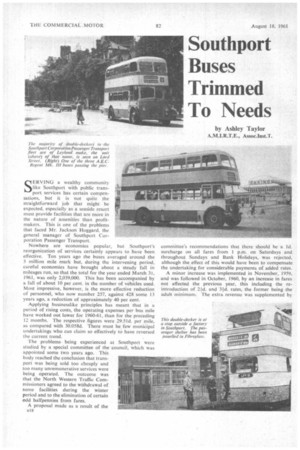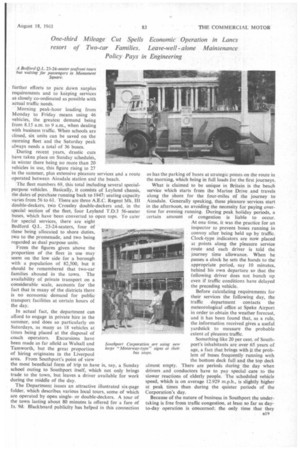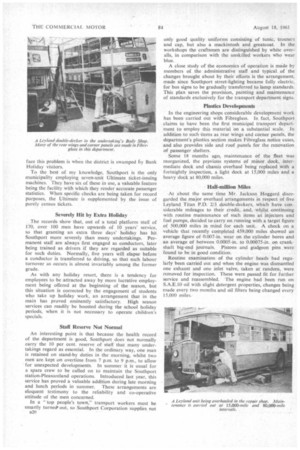Southport Buses Trimmed To Needs
Page 52

Page 53

Page 54

If you've noticed an error in this article please click here to report it so we can fix it.
One-third Mileage Cut Spells Economic Operation in Lanes resort of Two-car Families. Leave-well -alone Maintenance Policy Pays in Engineering
by Ashley Taylor A.M.I.R.T.E., Assoc.Inst.T.
SERVING a wealthy community like Southport with public transport services has certain compensations, but it is not quite the straightforward job that might be expected, especially as a seaside resort must provide facilities that are more in the nature of amenities than profitmakers. This is one of the problems that faced Mr. Jackson Hoggard. the general manager of Southport Corporation Passenger Transport.
Nowhere are economies popular, hut Southport's reorganization of services certainly appears to have been effective. Ten years ago the buses averaged around the 3 million mile mark but, during the intervening period, careful economies have brought about a steady fall in mileages run, so that the total for the year ended March 31, 1961, was only 2,039,000. This has been accompanied by a fall of about 10 per cent, in the number of vehicles used. Most impressive, however, is the more effective reduction of personnel, who now number 257, against 428 some 13 years ago, a reduction of approximately 40 per cent.
Applying businesslike principles has meant that in a period of rising costs, the operating expenses per bus mile have worked out lower for 1960-61, than for the preceding 12 months. The respective figures were 29.51d. per mile, as compared with 30.058d. There must be few municipal undertakings who can claim so effectively to have reversed the current trend.
The problems• being experienced at Southport were studied by a special committee of the council, which was appointed some two years ago. This body reached the conclusion that transport was being sold too cheaply and too many unremunerative services were being operated. The outcome was that the North Western Traffic Commissioners agreed to the withdrawal of some facilities during the winter period and to the elimination of certain odd halfpennies from fares.
A proposal made as a result of the committee's recommendations that there should be a Id. surcharge on all fares from 1 p.m. on Saturdays and throughout Sundays and Bank Holidays, was rejected, although the effect of this would have been to compensate the undertaking for considerable payments of added rates.
A minor increase was implemented in November, 1959, and was followed in October, 1960, by an increase in fares not affected the previous year, this including the reintroduction of 2;d. and 31d. rates, the former being the adult minimum. The extra revenue was supplemented by further efforts to pare down surplus requirements and to keeping services as closely co-ordinated as possible with actual traffic needs.
Morning peak-hour loading from Monday to Friday means using 46 vehicles, the greatest demand being from 8.15 a.m. to 9 a.m., when dealing with business traffic. When schools are closed, six units can be saved on the morning fleet and the Saturday peak always needs a total of 36 buses.
During recent years, drastic cuts have taken place on Sunday schedules, in winter there being no more than 20 vehicles in use, this figure rising to 27 in the summer, plus extensive pleasure services and a route operated between Ainsdale station and the beach.
The fleet numbers 69, this total including several specialpurpose vehicles. Basically, it consists of Leyland chassis, the dates of purchase running back to 1947: seating capacity varies from 56 to 61. There are three A.E.C. Regent Mk. III double-deckers, two Crossley double-deckers and, in the special section of the fleet. four Leyland T.D.3 56-seater buses, which have been converted to open tops. To cater for special services, there are eight Bedford Q.L. 23-24-seaters, four of these being allocated to shore duties, Iwo to the promenade, and two being regarded as dual purpose units.
From the figures given above the proportion of the fleet in use may seem on the low side for a borough with a population of 82,500, but it should be remembered that two-car families abound in the town. The availability of private transport on a considerable scale, accounts for the fact that in many of the districts there is no economic demand for public transport facilities at certain hours of the day.
In actual fact, the department can afford to engage in private hire in the summer, and does so particularly on Saturdays, as many as 18 vehicles at times being placed at the disposal of coach operators. Excursions have been made as far afield as Walsall and Tamworth, but the great proportion of hiring originates in the Liverpool area. From Southport's point of view the most beneficial form of trip to have is, say, a Sunday school outing to Southport itself, which not only brings trade to the town, but leaves a driver available for work during the middle of the day.
The Department issues an attractive illustrated six-page folder, which describes various local tours, some of which are operated by open singleor double-deckers. A tour of the town lasting about 80 minutes is offered for a fare of Is. 9d. Blackboard publicity has helped in this connection as has the parking of buses at strategic points on the route in the morning, which bring in full loads for the first journeys.
What is claimed to be unique in Britain is the beach service which starts from the Marine Drive and travels along the shore for the four-miles of the journey to Ainsdale. Generally speaking, these pleasure services start in the afternoon, so avoiding the necessity for paying overtime for evening running. During peak holiday periods, a certain amount of congestion is liable to occur. At one time, it was the practice for an inspector to prevent buses running in convoy after being held up by traffic. Clock-type indicators are now placed at points along the pleasure service route and each driver is told the journey time allowance. When he passes a clock he sets the hands to the appropriate period, say 10 minutes, behind his own departure so that the following driver does not bunch up even if traffic conditions have delayed the preceding vehicle.
Before calculating requirements for their services the following day, the traffic department contacts the meteorological office at Speke Airport in order to obtain the weather forecast, and it has been found that, as a rule, the information received gives a useful yardstick to measure the probable extent of pleasure traffic.
Something like 20 per cent. of Southport's inhabitants are over 65 years of age, a fact that brings with it the problem of buses frequently running with the bottom deck full and the top deck almost empty. There are periods during the day when drivers and conductors have to pay special care to the slower reactions of elderly people. The scheduled vehicle speed, which is on average 12.929 m.p.h., is slightly higher at peak times than during the quieter periods of the Corporation's day.
Because of the nature of business in Southport the undertaking is free from traffic congestion, at least so far as dayto-day operation is concerned; the only time that they B19 face this problem is when the district is swamped 6y Bank Holiday visitors.
To the best of my knowledge, Southport is the only municipality employing seven-unit Ultimate ticket-issuing machines. They have six of these in use, a valuable feature being the facility with which they render accurate passenger statistics. When specific checks are being taken for record purposes, the Ultimate is supplemented by the issue of purely census tickets.
Severely Hit by Extra Holiday
The records show that, out of a total platform staff of 170, over 100 men have upwards of 10 years' service, so that granting an extra three days' holiday has hit Southport more severely than many undertakings. Permanent staff are always first engaged as conductors, later being trained as drivers if they are regarded as suitable for such duties. Normally, five years will elapse before a conductor is transferred to driving, so that such labour turnover as occurs is almost invariably among the former grade.
As with any holiday resort, there is a tendency for employees to be attracted away by more lucrative employment being offered at the beginning of the season, but this situation is corrected by the engagement of students who take up holiday work, an arrangement that in the main has proved eminently satisfactory. High season services can readily be boosted during the school holiday periods, when it is not necessary to operate children's specials.
Staff Reserve Not Normal
An interesting point is that because the health record of the department is good, Southport does not normally carry the 10 per cent. reserve of staff that many undertakings regard as essential. In the ordinary way, one man is retained on stand-by duties in the morning, whilst two men are kept on overtime from 7 p.m. to 9 p.m., to allow for unexpected developments. In summer it is usual for a spare crew to be called on to maintain the Southport station-Pleasureland operations. Introduced last year, this service has proved a valuable addition during late morning and lunch periods in summer. These arrangements are eloquent testimony to the reliability and co-operative attitude of the men concerned.
In a "top people's town,transport workers must be smartly turne& out, so Southport Corporation supplies not a20
only good quality uniforms consisting of tunic; trousers and cap, but also a mackintosh and greatcoat. In the workshops the craftsmen are distinguished by white overalls, in comparison with the unskilled workers who wear blue.
A close study of the economics of operation is made by members of the administrative staff and typical of the changes brought about by their efforts is the arrangement, made since Southport street-lighting became fully electric, for bus signs to be gradually transferred to lamp standards. This plan saves the provision, painting and maintenance of standards exclusively for the transport department signs.
Plastics Developments In the engineering shops considerable development work has been carried out with Fibreglass. In fact, Southport claims to have been the first municipal transport department to employ this material •on a substantial scale. In addition to such items as rear wings and corner panels, the department's plastics section makes Fibreglass notice cases, and also provides side and roof panels for the renovation of passenger shelters.
Some 18 months ago, maintenance of the fleet was reorganized, the previous systems of minor dock, intermediate dock and chassis overhaul being replaced with a fortnightly inspection, a light dock at 15,000 miles and a heavy dock at 80,000 miles.
Half-million Miles
At about the same time Mr. Jackson Hoggard disregarded the major overhaul arrangements in respect of five Leyland Titan P.D. 2/3 double-deckers, which have considerable mileages to their credit, and, whilst continuing with routine maintenance of such items as injectors and fuel pumps, decided to carry on running with a target figure of 500,000 miles in mind for each unit. A check on a vehicle that recently completed 459,000 miles showed an average figure of 0.007-in, wear on the cylinder bores and an average of between 0.0005-in. to 0.00075-in, on crankshaft big-end journals. Pistons and gudgeon pins were found to be in good condition.
Routine examination of the cylinder heads had regularly been carried out and when the engine was dismantled one exhaust and one inlet valve, taken at random, were removed for inspection. These were passed fit for further service and reassembled. The engine had been run on S.A.E.10 oil with slight detergent properties, changes being made every two months and oil filters being changed every 15,000 miles.




















































































































